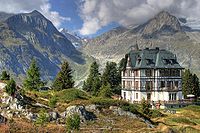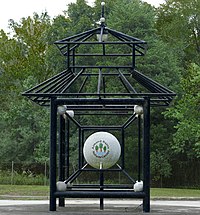The Arizona-Sonora Desert Museum is a 98-acre zoo, aquarium, botanical garden, natural history museum, publisher, and art gallery founded in 1952. Located just west of Tucson, Arizona, it features two miles (3.2 km) of walking paths traversing 21 acres of desert landscape. It is one of the most visited attractions in Southern Arizona.
The Oregon Museum of Science and Industry is a science and technology museum in Portland, Oregon, United States. It contains three auditoriums, including a large-screen theatre, planetarium, and exhibition halls with a variety of hands-on permanent exhibits focused on natural sciences, industry, and technology. Transient exhibits span a wider range of disciplines.

The Nature Center at Shaker Lakes is a nonprofit organization in Shaker Heights, Ohio, that works to conserve a natural area, educate visitors about nature, and promote better environmental stewardship. It was founded in 1966 as the result of a volunteer effort to preserve the Shaker Parklands from becoming the route for a new freeway connecting Cleveland's east side to Downtown Cleveland.

Earthplace is a non-profit science education organization, in Westport, Connecticut, in the United States. Its main focus is on the natural world and sustainability.
The Forest Preserve District of DuPage County is a governmental agency headquartered in Wheaton, Illinois, United States. Its mission is to acquire and hold lands containing forests, prairies, wetlands, and associated plant communities or lands capable of being restored to such natural conditions for the purpose of protecting and preserving the flora, fauna and scenic beauty for the education, pleasure and recreation of the citizens of DuPage County.

The North Carolina Museum of Natural Sciences (NCMNS) is a natural history museum in Raleigh, North Carolina. The museum is the oldest in the state, and the largest natural history museum in the Southeastern United States.

The Rio Grande Nature Center State Park is a New Mexico State Park located adjacent to the Rio Grande in Albuquerque, New Mexico, US. The Rio Grande Nature Center is a 38-acre urban wildlife preserve established in 1982. About two thirds of the grounds of the park are set aside as habitat for wildlife. The remaining acreage contains a visitors' center, two gardens, several wildlife viewing areas, an education building and a building housing the non-profit Wildlife Rescue, Inc. There are four constructed ponds which provide habitat for birds and other wildlife and which mimic wetland features of the historical flood plain of the Rio Grande.

The Rochester Museum & Science Center (RMSC) is a museum in Rochester, New York, dedicated to community education in science, technology and local history. The museum also operates the Strasenburgh Planetarium, located next to the museum, and the Cumming Nature Center, a 900-acre (3.6 km2) nature preserve near Naples, New York. The museum resides at 657 East Ave. and has a collection of 1.2 million artifacts.
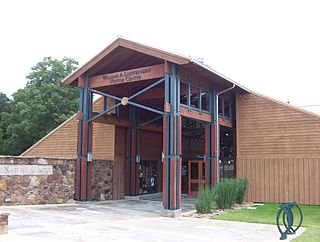
Lichterman Nature Center is a certified arboretum and nature center located in East Memphis, Tennessee. It has many outdoor and indoor animal exhibits, as well as several activities and events. The Lichterman Nature Center is one of the facilities within the Pink Palace Family of Museums.
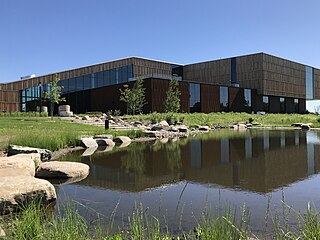
The Bell Museum, formerly known as the James Ford Bell Museum of Natural History, is located at the University of Minnesota's Saint Paul campus. The museum's current location on the Saint Paul campus opened in 2018. The Minnesota wildlife dioramas showcase animal specimens from around the world. The museum also houses the digital Whitney and Elizabeth MacMillan Planetarium. The museum is part of the university's College of Food, Agricultural and Natural Resource Sciences. The museum's former location on University of Minnesota's Minneapolis campus closed in January 2017.

Teatown Lake Reservation is a nonprofit nature preserve and environmental education center in Westchester County, New York, U.S., located in the towns of Ossining, Yorktown, Cortlandt, and New Castle. The reservation includes an 1,000-acre (4.0 km2) nature preserve and education center, visited annually by around 25,000 people.
The Lime Hollow Center for Environment and Culture is a nature preserve project in Cortland County, New York. It was founded in 1993 as the Lime Hollow Nature Center, the culmination of efforts 20 years earlier to develop a nature preserve to protect an unusual assemblage of marl ponds, a peat bog, and kame-and-kettle topography along an abandoned railroad right of way in Lime Hollow, just west of the city of Cortland.
Oxbow Park and Zollman Zoo are a campground and zoo located in Olmsted County, Minnesota, United States, north of the city of Byron, and about 4.5 miles (7.2 km) west of Rochester. It houses over 30 species of animals, most of which have injuries that would prevent them from surviving in the wild. All of the animals are native to Minnesota. The zoo is named after Dr. Paul E. Zollman. The most popular animals include a wolf, bald eagle, white-tailed deer, coyotes, bobcat, river otters, bison and cougar. Oxbow Park is open most of the year, as is Zollman Zoo, with a majority of the animals being visible year round.
The Nature and Wildlife Discovery Center is a multi-campus nature preserve and educational center in Pueblo County, Colorado, United States. The NWDC is a 501 (c)(3) tax-exempt corporation which includes a 611 acres (247 ha) mountain park, lodge, gift shop, and museum in Beulah, a small museum and educational center as well as an open-space park on the Arkansas River in Pueblo, and an adjacent raptor education and rehabilitation facility.

The Stamford Museum & Nature Center, located in Stamford, Connecticut, is an art, history, nature, and agricultural sciences museum. The property covers 118 acres beginning about half a mile north of the Merritt Parkway. It was originally a private estate.

The White Memorial Conservation Center is a natural history museum and nature center in Litchfield, Connecticut, United States, supported by the White Memorial Foundation. The museum is currently housed in Whitehall, the former residence of White Memorial Foundation founders Alain and May White.
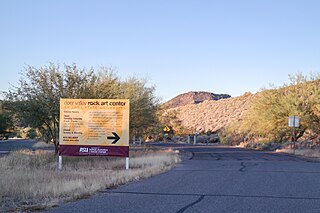
The Deer Valley Petroglyph Preserve, formerly known as the Deer Valley Rock Art Center, is a 47-acre nature preserve featuring over 1500 Hohokam, Patayan, and Archaic petroglyphs visible on 500 basalt boulders in the Deer Valley area of Phoenix, Arizona. In 1980, the US Army Corps of Engineers contracted J. Simon Bruder to conduct an archaeological investigation prior to the construction of the Adobe Dam at the Hedgpeth Hills. The petroglyphs are between 500 and 5,000 years old. The site was listed on the National Register of Historic Places in 1984, and it was also listed with the Phoenix Points of Pride. The preserve and museum are operated by the ASU College of Liberal Arts and Sciences's School of Human Evolution and Social Change.

A private 501(c)3 nonprofit organization founded in 1967, the Heard Natural Science Museum & Wildlife Sanctuary is located in McKinney, Texas, United States. With a 289-acre wildlife sanctuary, five miles of hiking trails, about fifty acres of wetlands, a two-acre native plant garden, a butterfly house, live animals, indoor and outdoor exhibits, the Heard welcomes over 100,000 visitors annually. The Heard is one of the most important attractions in the City of McKinney.

The Cumming Nature Center (CNC) is a 900-acre environmental education facility located near Naples, New York. Owned by the Rochester Museum & Science Center (RMSC), the preserve features over fifteen miles of trails and offers educational programs and service-learning opportunities. Established in 1973 with a gift from the Cumming family to the Rochester Museum & Science Center, CNC's landscape is home to a diverse variety of habitats, including abandoned fields, conifer plantations, swamps, marshes, ponds, and upland forests. Visitors can also explore a Visitor Center featuring a variety of educational exhibits, interactive play areas, and classroom space.

Churchville Nature Center is a facility of the Bucks County, Pennsylvania Department of Parks and Recreation and is located in Churchville, Pennsylvania. The center focuses on environmental education, public outreach and the preservation of native wildlife through its wide range of programs, projects and surveys. The nature center offers educational programing year round through its Environmental Education and Lenape Village departments. The center features a native butterfly house and covers 55 acres of wildlife preserve.
